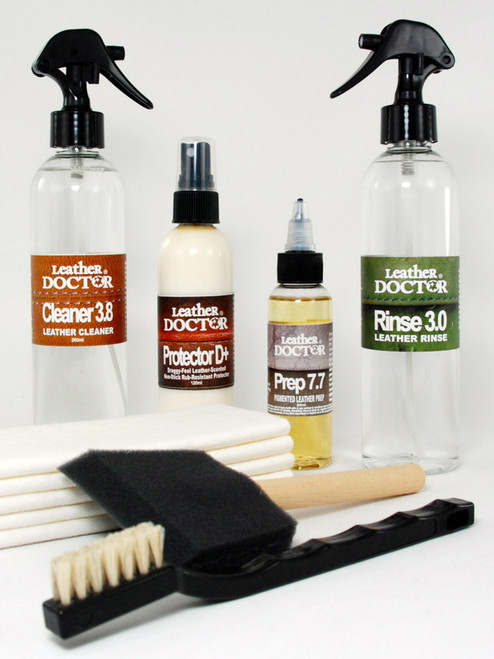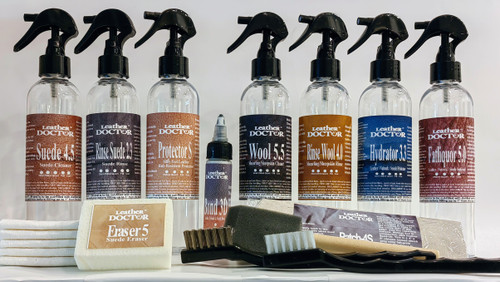Product Overview
Leather Repair Kit A8.r by Leather Doctor is a patching, filling, bonding, tightening, and smoothening repair system that supplements refinishing kits.
This Leather Repair Kit A8.r includes five handpicked products: a
1: 1oz Leather Glue 3D, a
2: 1oz Leather Abrasion Repairer R4, a
3: 1oz Leather Stucco 9S, and a
4: 2oz Leather Impregnator 26, a
5: 6 x 4" 0.4mm lambskin Leather Patch 4S.
1. 1: Glue 3D for bonding repair is a water-based resin bond that becomes part of leather and often works with Patch 4S for leather repairs.
2. 1: Repairer R4 for smooth repairs, smooths the rough abraded surface and becomes part of the leather surface grain for further coat dyeing.
3. 1: Stucco 9S for filling repairs fills up gaps and holes for further repairs.
4. 1: Impregnator 26 for tightening repairs penetrates the weakened, overstretched leather and tightens it becoming part of the leather.
5. 1: Patch 4S for patching is a lambskin leather sub-patch for rip or tear repairs with a thickness of only 0.4mm, which becomes less noticeable at the edges.
1. 1.1: Leather Glue 3D aka Bond 3D by Leather Doctor is a water-based medium soft leather adhesive for tears, rips, cat scratches, and bonding repairs. Glue 3D will not lift or damage the leather finishes, unlike other dry solvent-based glue. Glue 3D works in conjunction with Leather Patch 4S as sub-patch or suede fibers as fillers.
People Also Ask:
1. 1.1.1: How to Repair a Leather Cut-Through with Glue 3D?
1. 1.1.2: How to Repair a Fresh and Clean Accident Leather Abrasion with Glue 3D
1. 1.1.3: How to Repair a Prolonged Contaminated Leather Abrasion & Holes with Glue 3D?
1. 1.1.4: How to Repair Hair-on-Hide Leather Rip or Tear Repair with Glue 3D?
1. 1.1.5: How to Repair Hair-on-Hide Leather with Glue 3D and Patch 4S?
1. 1.1.6: How to Repair Hair-on-Hide Leather with Glue 3D by Stitching and Donor Fiber?
1. 1.1.7: How to Repair Cracks on Leather with Glue 3D?
1. 1.1.1: How to Repair a Leather Cut-Through with Glue 3D?
1. 1.1.1.1: Cut-through repairs utilize Patch 4S as a leather sub-patch and this is bonded suede side to suede side.
1. 1.1.1.2: Where tension causes the leather to open, it is stretched to an overlapping position with some pulling help.
1. 1.1.1.3: Preferably the Patch 4S is glued to one side first before gluing the other side to reduce the overlapping effort.
1. 1.1.1.4: This is a slow-drying product thus a blower may come helpful to speed up the drying process.
1. 1.1.1.5: The bonding process will require the glue to cure for tension strength, thus holding the rip in position until fully cured is necessary.
1. 1.1.1.6: Vertical filling gap may be done with added matching coloring for aesthetic.
1. 1.1.2: How to Repair a Fresh and Clean Accident Leather Abrasion with Glue 3D?
1. 1.1.2.1: Abrasion in most cases will roughen up the leather structure with missing finishes.
1. 1.1.2.2: Any soiling is removed with brushing prior to applying Glue 3D to smooth the damages.
1. 1.1.2.3: Repeat application is necessary to build the smooth skin back gradually.
1. 1.1.2.4: Color matching is done accordingly to the finish types.
1. 1.1.3: How to Repair a Prolonged Contaminated Leather Abrasion & Holes with Glue 3D?
1. 1.1.3.1: Constant abrasion with repeat compression may loosen and weaken the leather structure compound with a loss of fibers or missing parts.
1. 1.1.3.2: Repairs to such neglected damages may take on a holistic approach to restore systematically the damages.
1. 1.1.3.3: Degreasing with Degreaser 2.2 is recommended to remove surface and penetrated oil and grease soiling in conjunction with Rinse 3.0 to remove foreign contamination.
1. 1.1.3.4: Leather rejuvenation is also recommended to restore the leather's softness and strength with Hydrator 3.3 followed by Fatliquor 5.0.
1. 1.1.3.5: Tightening the leather structure may be necessary to restore over-stretched leather with Impregnator 26.
1. 1.1.3.6: Shallow abrasion is first smooth with Repairer R4.
1. 1.1.3.7: Bonding repair with Glue 3D commence thereafter with smoothening, and filling with donor suede fiber, especially for aniline leathers.
1. 1.1.3.8: Repair prepares the surface for color refinishing that follows with Adhesor 73, matching coloring, and matching topcoat that ends with rub-resistant protection with Protector B.
1. 1.1.4: How to Repair Hair-on-Hide Leather Rip or Tear Repair with Glue 3D?
1. 1.1.4.1: Rip or tear is the result of diminished fatliquor (ionic charged fat and oil) from aging or alkaline overexposure.
1. 1.1.4.2: The structure needs to be clean, pH balanced and fatliquor replenished up to 15% to supple it before repairing, otherwise the stiff hide may tend to tear again when flexed.
1. 1.1.4.3: The repair may be performed with a bonding Patch 4S or with stitching and camouflaging donor suedefibers.
1. 1.1.5: How to Repair Hair-on-Hide Leather with Glue 3D and Patch 4S?
1. 1.1.5.1: A 1” Patch 4S strip is sufficient to bond a rip with approximately 1/2” on both sides.
1. 1.1.5.2: Glue 3D is applied sufficiently to half an inch along the rip to penetrate and the 1” Patch 4S is also applied half sufficiently.
1. 1.1.5.3: The Patch 4S is placed and pressed accordingly.
1. 1.1.5.4: Let naturally dry with the hair drying option before repeating the other half and align accordingly.
1. 1.1.5.5: Let overnight cure and the hide is ready to flip over to proceed with cleaning the hair side.
1. 1.1.6: How to Repair Hair-on-Hide Leather with Glue 3D by Stitching and Donor Fiber?
1. 1.1.6.1: The hide is cross-stitched with a curve needle to hold the rip together.
1. 1.1.6.2: Glue 3D is applied about ½” on both sides of the rip.
1. 1.1.6.3: Donor fiber is scraped with Razor 60 from the thicker areas of the hide, especially the head and shoulder areas, and applied over the stitching camouflaging it.
1. 1.1.6.4: The repair is left to naturally dry or option drying with a hair dryer.
1. 1.1.6.5: Let overnight cure and the hide is ready to flip over to proceed with cleaning the hair side.
1. 1.1.7: How to Repair Cracks on Leather with Glue 3D?
1. 1.1.7.1: Leather is degreased, pH balanced, clean, and rinse accordingly.
1. 1.1.7.2: Soiling is removed and scrap cleaned to reveal the suede fiber.
1. 1.1.7.3: Fillers like thread and suede fiber are used as fillers and bond with Glue 3D.
1. 1.1.7.4: This system will ensure the bonding is stronger and lasts longer when compared with other filling types of products.
1. 1.1.7.5: Note: Leather filler and stucco repairs often show signs of early failure in cracking and your refinishing to cover it up has gone to waste too soon.
2. 1.1: Leather Abrasion Repairer R4 by Leather Doctor is a water-based compact resin to smooth dog and cat scratches, and abraded edges of soft skin leathers. Highly recommend to hydrate and fatliquor aged and dry rotting leather before scratches and abrasion repairs. Instruction:
2. 1.1.1: Test for darkening effect when dry to confirm satisfaction,
2. 1.1.2: Apply using the edge of a teaspoon to spread the R4.
2. 1.1.3: Smooth the abrasion laying down in one direction to build skin back.
2. 1.1.4: The repair is ready for further color coating and or top coating.
2. 1.1.5: Patching with Patch 4S is a lambskin leather sub-patch for rip or tear repairs with a thickness of only 0.4mm, which becomes less noticeable at the edges.
3. 1.1: Leather Filler Stucco 9S, by Leather Doctor, is a concentrated, compact resin blend for filling repairs or for custom blending with Glue 3D, Micro 54, or Aniline 76.
3. 1.1.1: Tips: Dried leather is hydrated to relax with Hydrator 3.3 and fatliquored to soften with Fatliquor 5.0 system with strength before repair.
3. 1.1.2: Tips: Structural weakness from cracking and looseness from overstretching is tightened and strengthened with Impregnator 26 before repair.
3. 1.1.3: Tips: For added strength and flexibility in high-stress areas, blend with Glue 3D.
3. 1.1.4: Tips: For smooth abraded or rough grain texture use Repairer R4.
3. 1.1.5: Instruction: Apply to cleaned surface for better anchorage and adhesion.
3. 1.1.6: Instruction: Clean up surrounding areas immediately with a damp towel and let dry.
3. 1.1.7: Instruction: Refill as necessary and leave 4 to 8 hours of curing time.
3. 1.1.8: Instruction: Sand the repair surface seamlessly with fine sandpaper.
3. 1.1.9: Instruction: Refinishing options are recommended.
4. 1.1: Leather Impregnator 26 by Leather Doctor is a resin-blend compound that strengthens overstretched leathers by impregnating the loose fiber structure and micro cracks.
4. 1.1.1: Instruction: Before use, the concentrate has to be mixed with distilled water at a ratio of 1: 2.
4. 1.1.2: Instruction: Shake well, and brush to saturate all weak, overstretched, and highly absorbent damaged areas.
4. 1.1.3: Instruction: Concentrate on weak areas otherwise wipe off unnecessary excess to prevent surface build-up.
4. 1.1.4: Instruction: Sand off surface excess when dry with 1000/2000grit sandpaper.
5. 1.1: Leather Patch 4S by Leather Doctor is a lambskin leather sub-patch for rip or tear repairs with a thickness of only 0.4mm, which becomes less noticeable at the edges. Leather Patch 4S is a 4" x 6" chrome tanned bluish grey color full-grain leather with smooth grain on one side and suede on the other.
5. 1.1.1: How to Use Leather Patch 4S? In a surface grain repair, the bonding is done from the grain side of the patch to the suede side of the damaged leather. For better bonding of tear and rip without missing parts it is done suede side to suede side. Always use in conjunction with leather Glue 3D.












